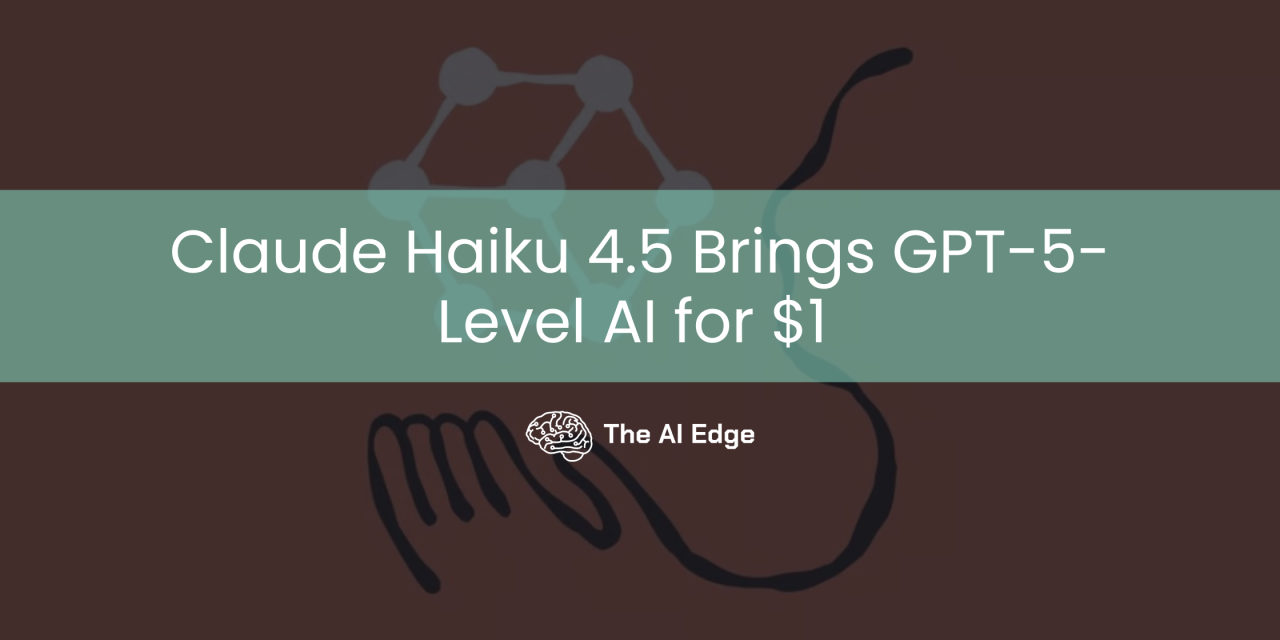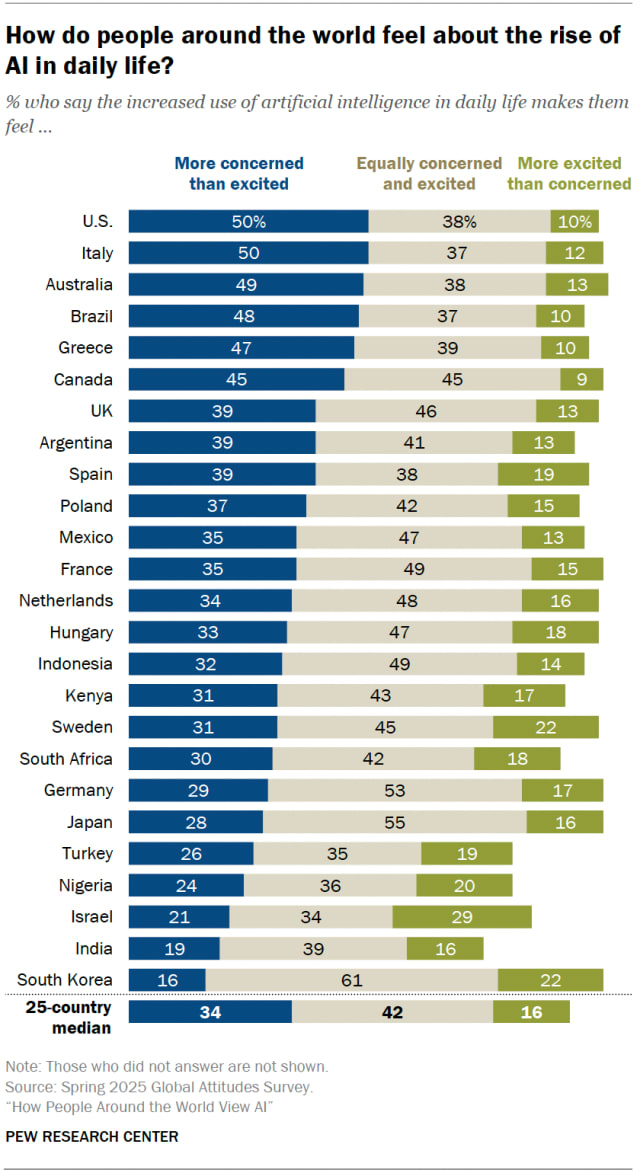Hello Engineering Leaders and AI Enthusiasts!
This newsletter brings you the latest AI updates in just 4 minutes! Dive in for a quick summary of everything important that happened in AI over the last week.
And a huge shoutout to our amazing readers. We appreciate you😊
In today’s edition:
🪶 Anthropic drops fast, low-cost Claude Haiku 4.5
🌐 OpenAI launches ChatGPT Atlas browser
📊 Survey: Google leads Generative media race
🎥 Odyssey-2 brings real-time AI video
🌎 Pew’s global survey reveals AI jitters
💡 Knowledge Nugget: Agentic AI is moving from hype to structure by Or Weis
Let’s go!
Anthropic drops fast, low-cost Claude Haiku 4.5
Anthropic has released Claude Haiku 4.5, a compact, high-speed model that delivers performance comparable to its premium Sonnet 4 model at just a third of the price. The new Haiku matches Sonnet’s coding ability while improving tasks like math, agentic reasoning, and computer use.
Despite being the smallest model in the Claude 4.5 lineup, Haiku 4.5 supports advanced agentic workflows. Enterprises can now deploy multiple lightweight agents running in parallel, coordinated by the more capable Sonnet 4.5 model. The release is available across all Claude tiers, including API and Claude Code.
Why does it matter?
Claude Haiku 4.5 signals how fast the cost curve in AI is collapsing. The idea that advanced intelligence can be both small and cheap is becoming the new baseline for how AI will scale across industries.
OpenAI launches ChatGPT Atlas browser
OpenAI has unveiled Atlas, a new AI browser that brings ChatGPT directly into the web experience. Built with ChatGPT at its core, Atlas allows users to interact with the assistant through a sidebar and leverage “Agent mode” for autonomous web actions like navigating pages or completing simple tasks online.
Atlas also introduces “memories,” enabling ChatGPT to recall details from visited sites to deliver personalized and context-aware responses. While currently limited to Mac users in preview, Atlas is available for Plus, Pro, and Business subscribers.
Why does it matter?
The launch puts pressure on early AI browser players like Comet and Dia, but it’s more strategic positioning than a breakthrough moment, an early step in OpenAI’s plan to make ChatGPT the default way people interact with the web.
Survey: Google leads the Generative media race
Artificial Analysis’s 2025 State of Generative Media report highlights just how concentrated the AI creation market has become. Google’s Gemini captured 74% of AI image usage, while its Veo model took 69% of video creators, leaving OpenAI, Midjourney, and others trailing behind.
Adoption among personal creators remains high, with 89% using AI image tools and 58% incorporating video generation. On the enterprise side, 65% of organizations say they’ve achieved ROI from AI media projects within a year, and a third already report profits. Across all respondents, model quality ranked as the most important factor in tool selection, well above cost or speed.
Why does it matter?
Google’s grip on both AI image and video tools is tightening, in contrast to OpenAI’s usual dominance elsewhere. The strong ROI figures here cut through the skepticism surrounding enterprise AI adoption, showing that, at least in generative media, the payoff is already real.
Odyssey-2 brings real-time AI video
Odyssey has launched Odyssey-2, a next-generation AI video model that creates and streams footage in real time at 20 frames per second. Instead of rendering short clips after lengthy waits, the model produces new frames every 50 milliseconds, letting users watch and direct evolving scenes instantly.
What makes Odyssey-2 stand out is its interactivity. Users can guide the video midstream through chat prompts, adjusting scenes, motion, or style as they unfold. Trained on dynamic visual data, it simulates realistic physics like waves or lighting shifts without pre-planning frames, making it one of the most fluid demonstrations of generative video to date.
Why does it matter?
Odyssey-2 is more like a live simulation engine. The visual fidelity may not yet match Veo or Sora, but the real-time interactivity and open-ended control hint at a new genre of AI-driven experiences.
Pew’s global survey reveals AI jitters
Pew Research’s latest global survey shows that AI anxiety is rising faster than optimism. In a poll of 28,000 adults across 25 countries, half of the respondents in the U.S., Italy, Australia, and Greece said they feel nervous about the technology’s rapid spread. By contrast, Israel, South Korea, and Sweden emerged as the most optimistic, reflecting how regional exposure and cultural attitudes shape perceptions of AI.
Trust in governance remains uneven. The European Union topped confidence ratings for AI oversight at 53%, outpacing both the U.S. (37%) and China (27%). Age also plays a major role; young adults under 35 report far higher awareness and enthusiasm than older generations, suggesting that familiarity continues to be the best antidote to fear.
Why does it matter?
Pew’s results reveal a global split; countries most exposed to AI often feel the most uneasy about it. It’s a reminder that while the tech world races ahead, much of the public is still catching up, unsure whether AI represents progress or a pending problem.
Enjoying the latest AI updates?
Refer your pals to subscribe to our newsletter and get exclusive access to 400+ game-changing AI tools.
When you use the referral link above or the “Share” button on any post, you’ll get the credit for any new subscribers. All you need to do is send the link via text or email or share it on social media with friends.
Knowledge Nugget: Agentic AI is moving from hype to structure
In this piece, Or Weis explores Agentic AI shifting from sandbox demos to production workflows. Over the past year, enterprises have moved from one-off agents to connecting them with internal APIs, financial systems, and operational data. That jump has turned access control into a top-tier concern. Identity frameworks built for humans can’t handle the speed or autonomy of agents that now read, write, and trigger actions across multiple environments.
This is where a new infrastructure layer is emerging; one focused on granular, adaptive permissioning that spans both legacy and agentic systems. As “guardian agents” begin enforcing policies and monitoring other agents, security is becoming decentralized yet programmable. The next phase won’t be more startups; it’ll be aggregation and consolidation, as enterprises standardize how agents authenticate, collaborate, and self-govern.
Why does it matter?
Agentic AI is quickly evolving into the connective tissue of digital work. The winners will be companies that rebuild identity and access control around this reality, treating it not as a feature, but as core infrastructure.
What Else Is Happening❗
💫 Microsoft introduced Mico, an animated Copilot avatar, alongside new features like memory-based personalization, AI collaboration groups, and health tools powered by Harvard Health.
🕶️ Amazon unveiled AI smart glasses for delivery drivers that project navigation and package data in real time, cutting phone use and boosting route efficiency.
🧬 Nucleus Genomics launched Origin, an AI system that analyzes embryonic DNA to predict disease risks like Alzheimer’s and cancer.
💻 Anthropic launched Claude Code on the web with browser-based coding, multitasking, GitHub integration, and isolated workspaces.
🎧 Napster 26 reinvents Napster as an AI platform with 3D holographic assistants, 15k+ companions, and customizable digital twins for work or wellness.
🗺️ Google integrated Gemini with Maps, giving AI access to 250M+ locations and enabling apps to embed map data, ratings, and venue details.
🧩 Anthropic released Skills for Claude, letting teams package workflows into reusable folders the AI can load to run complex multi-step tasks.
🎬 Google introduced Veo 3.1 with more realistic video generation, image-to-video transitions, and filmmaker tools for smoother scenes and consistent characters.
New to the newsletter?
The AI Edge keeps engineering leaders & AI enthusiasts like you on the cutting edge of AI. From machine learning to ChatGPT to generative AI and large language models, we break down the latest AI developments and how you can apply them in your work.
Thanks for reading, and see you next week! 😊
Read More in The AI Edge





